I’m at that age and experience level where I can confidently teach from my mistakes (which is another way to say, “Listen up kiddies…”). As is prone to many young testosterone filled men, I thought my body would be young and resilient forever so I made a lot of the mistakes concerning training . These mistakes caught up with me, and they led to a series of injuries and poor health that prevented me from serious climbing for a few years. But now, with a new and healthier approach to climbing, I’m getting back to top form quickly and safely. And it starts with a smart warm up routine.
Now that many of the iGuideKorea Dragon Boat paddlers have started rock climbing, I feel like its a great time to write this post to help novice climbers develop good training habits and prevent injuries. To that purpose, I’ll be sharing what I’ve learned through my 20+ years of climbing to help keep them injury-free and strong. My hope is that new and old veteran climbers will learn from my mistakes so that they can progress safely and can fully enjoy the climbing experience.
Warm up. I know it’s hard to get into warming up. Maybe your friends are already on the wall, laughing and having fun. The last thing you want to do is spend 10-15 minutes warming up alone. But you perform way better when warmed up. Climbing puts strain on some our smallest muscles and tendons so you need a solid warm up to make sure they are ready to deliver optimal performance.
I used to love the idea of being an ‘off-the couch’ climber. I would walk into the gym and try to send hard boulder problems in my approach shoes. What I remember most about those times is the lingering shoulder and finger injuries that still affect me today. The pain used to be so bad that I didn’t want to climb; and for a while, I didn’t. But after learning and (more importantly) doing what my body needed to perform optimally, I’m back fitter and stronger than ever. A proper warm up was the first step I took to better climbing.
Below is an outline of my suggested warm up routine. It’s divided around 4 important concepts: 1) Build strength, 2) Prevent injury, 3) Increase mobility and 4) Develop balance. The exercises in the routine consists of quick and slow dynamic movements. Not only does it work your climbing muscles, it works the often ignored antagonist/oppositional muscles. For any warm up, it’s important to raise your body temperature enough for a light sweat so try not rest too much between exercises. I usually go from one exercise to the next right away. Many of these exercises were derived from the Scientific 7-minute Workout, Dr. Jared Vagy’s The Ultimate Climber, and Mitch Owen’s The Climbers’ Project.
Here’s my sample warm up routine (for the more uncommon exercises, I have included photos and instruction):
Part 1: Build Strength
The objective in Part 1 is to get your heartbeat up in order to warm up the whole body. Most of the strength exercises revolve around the oppositional muscles (muscles you don’t use as much own climbing) which is why there are more ‘pushing’ exercise here.
- Jumping jacks 35sec
- Deep squats 35sec
- Pushups 35sec
- Situps 35sec
- Dips 35sec
- Leg raises 35sec
- Burpees 35sec
- repeat if needed (i.e. you did not get a mild sweat)
Part 2: Prevent Injury
These exercise are meant to help prevent injuries of smaller groups of muscles and tendons that often plague climbers. The following exercises come from numerous physical therapy sessions at I’ve had to fix my shoulders. I usually don’t use weights or resistance, but rather I focus more on motion and range of movement. Also, I do two sets of this routine.
- Subscapularis rotator cuff exercises 35sec
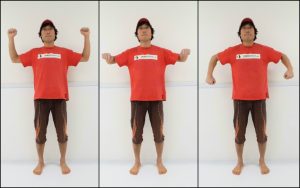
Bend your elbows at 90 degrees and then rotated your arms. Don’t drop your elbows and avoid excessive movement in the shoulders. Hold your position at the end of each movement for a second.
- Infraspinatus rotator cuff exercises 35sec
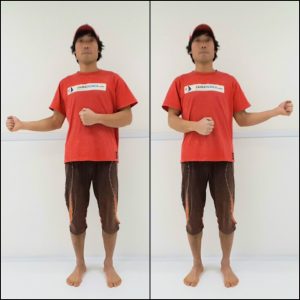
Keep your elbow bent at 90 degrees and then pull arm back as far as you can go and hold the position for a second. Alternate arms.
- Reverse wrist curls 35sec
- Repeat
Part 3: Increase Mobility
With research calling into question the benefits of static stretching before workouts, I have replaced my normal stretches with climbing-based movements. The important thing to remember is to push through the full range of movement so that when you are at the end of the movement you will feel a stretch. Not to get into the details but the difference between these movements and a normal stagnant stretch is that movement ‘stretches’ keep the target area activated rather than stressing cold or dormant muscles groups. By mimicking climbing movements with minimal resistance (i.e. without the force of gravity on your body), you can focus more on the details of your body going through the motions. You are more aware of which muscles are activated, and how the joints are rotating. These exercise are largely adapted from Mitch Owen’s The Climbers’ Project and Dr. Vagy’s The Ulitmate Climber.
- Lunge-cross through 20reps
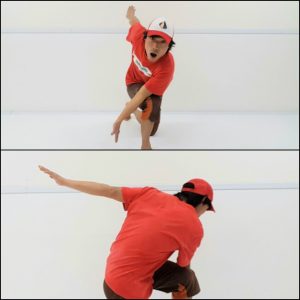
While performing a lunge cross your opposite arm to the outside of your thigh. Hold the end position and repeat on the other side.
- Cross reach 20reps
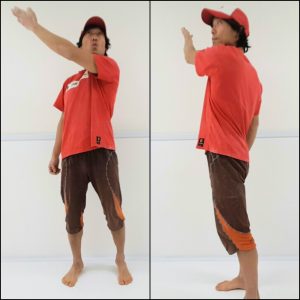
Reach your arm diagonally across while rotating your hand so that the palm faces up. Hold the last position. Alternate sides.
- Reverse outside flag 20reps
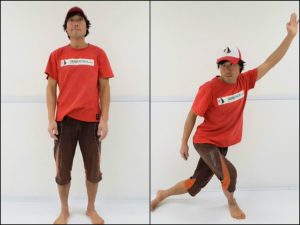
From standing position, bend one leg while cross the other leg behind. At the same time reach high with your hand. Bend your leg as far as you can go and then hold that position. Alternate sides.
- Side-to-side squat and flag 20reps
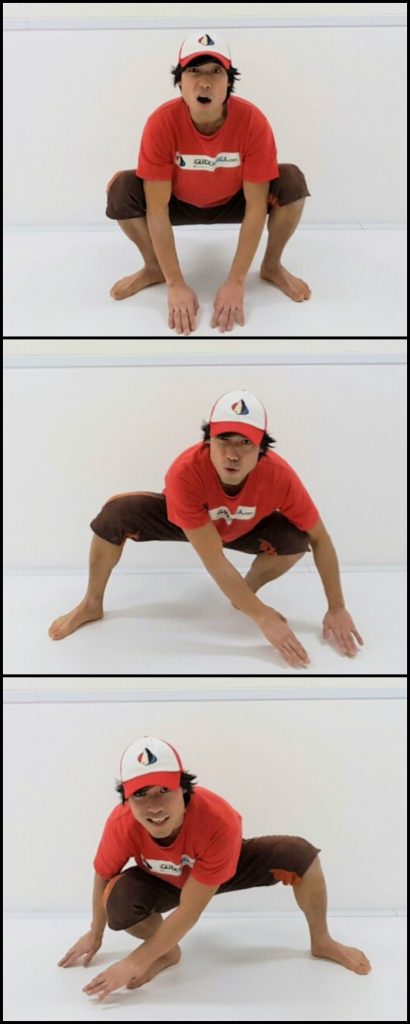
While in a deep squat position, move your hips and arms from side to side. Reach with your arms and hold that position.
- Shoulder rolls to wingspan 20reps
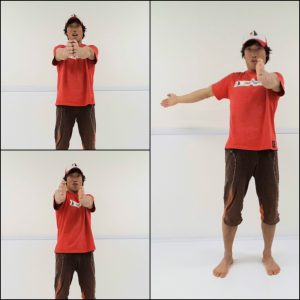
Put your arms in front of you with palms together. Reach one arm forward without moving your hips. Hold for a second. Then bring the same arm as far back as you can and hold. Return to the starting position and alternate arms.
- Wrist tendon glides 20reps
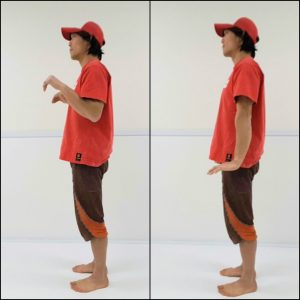
Raise your forearms and bend your wrists. Hold the position. Then fully extend your arms while rotating your wrists in the opposite direction.
- Finger tendon glides 20reps
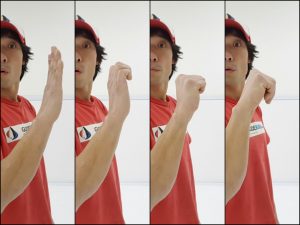
Start with your fingers fully extended. Then bend at the second joint. Next, bend them into a fist and finally try to reach your fingers downwards towards your wrist. Hold each movement.
Part 4: Balance
The last part of the warm up is to climb a juggy route (a route with big holds) very statically. We used to call this the “slow motion climber.” Your body is in a balanced position so that you’re not lunging for any hold. Focus on technique like flags, back-steps, shoulder rolls, or drop knees. Ease into the move and don’t rush. Do that route until you got a small pump in your forearms, and then massage the forearms. Now your engine is ready to rip through that next project.
The whole warm up can take 15 minutes. It’s high value 15 minutes, though. For one, you are keeping you body fit. Secondly, you are preventing injury, and nothing sucks the enjoyment and progression out of your climbing like an injury.
As mentioned previously, I’ve created this workout from numerous of sources, and I adapted it so that it can be done (or parts of it), at the gym or at the crag. I highly recommend you check out the online resources listed below and find what works best for you. I hope you begin to warm up to warming up!
Online Resources:
- Dr. Vagy is a board certified doctor of physical therapy. He’s a leading authority of climbing injuries.
https://theclimbingdoctor.com/how-to-climb-injury-free/
http://www.climbing.com/skills/injury-free-movement-for-rock-climbers/
- After years of studying climbers and their injuries, Mitch Owens created The Climbers’s Project.
http://www.unionpt.com/community/theclimbersproject
- Good starting articles explaining the effects of static stretching.
http://sock-doc.com/warm-up-stretching-injury/
https://breakingmuscle.com/learn/two-new-studies-on-static-stretching-are-completely-conflicting
- A comprehensive catalog of advice on different types of climbing injuries.